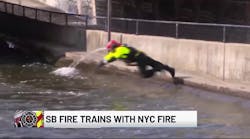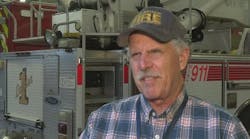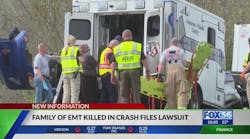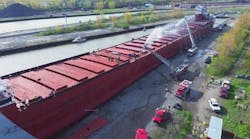Firefighter safety, risk management and insurance have taken on more and more interest in the past few years. We thought it was time to discuss current trends in risk management with one of the fire service's leading risk-management professionals. William F. Jenaway, Ph.D., CSP, CFOD, CFPS, has spent over 30 years in the field of risk management, was the chair of the International Association of Fire Chiefs (IAFC) Risk Management Task Force and then for 10 years was the chair of the National Fire Protection Association Fire Service Administrative Risk Management Committee (NFPA 1250). Having served as fire chief in two communities and vice president of VFIS, an insurer of emergency service organizations, Dr. Jenaway deals with the issue of fire department safety, risk management and insurance 24 hours a day, seven days a week. Our thanks to Dr. Jenaway and the VFIS team for assisting in this current assessment of fire service risk management.
FIREHOUSE: Over the past decade, what have you seen change in the area of fire service risk management?
JENAWAY: A decade ago, most fire departments had minimal concern over firefighter safety. Accidents were typically handled by worker compensation programs and while there was some loss-prevention or safety work being done, it was limited in application and success. Risk management was thought of as "safety" and while we did have an NFPA (National Fire Protection Association) standard for a safety officer and the FDSOA (Fire Department Safety Officers Association) were active, the whole concept of risk management was misapplied.
FIREHOUSE: Misapplied? What do you mean by misapplied?
JENAWAY: The early attempts at fire service risk management were safety (risk control or loss prevention) based. However, risk management is a multi-step decision-making process that involves a combination of risk-control and risk-financing techniques. Work had begun, but many initiatives were limited because they expected grandiose success from safety initiatives that are only partially responsible for safe operations. Keep in mind that safety as a true discipline is only about 40 years old (OSHA, the Occupational Safety and Health Administration, was implemented in the early 1970s). Risk management, the integration of risk control and risk financing, is still developing.
FIREHOUSE: What do you believe are some of the current issues that we face regarding risk management?
JENAWAY: The best way to explain these current challenges is to simply look at the headlines. We continue to experience approximately 100 firefighter deaths annually, some 80,000 injuries, fire truck accidents continue to rise in frequency and severity, and the newest problem — management liability or reputational risk — is becoming more and more prevalent and costly in more than one way to the fire service.
FIREHOUSE: What is reputational risk? Is this something new?
JENAWAY: This refers to the reputation of the fire department and how risk is affected by the actions or non-actions of members and officers. For instance, thefts by fire department members, other crimes, harassment claims, and discriminatory and unlawful practices all bring negative publicity to the fire department, which creates risk of financial loss, member loss or reputation loss. These problems typically surface in the news and result in claims or charges against the fire department and/or its members.
FIREHOUSE: What are some successes the fire service is experiencing?
JENAWAY: There are distinct success stories that we see around the country. These start with fire departments that take action and do not stick their heads in the sand regarding safety. Chiefs who ignore the issues of accident potential and how accidents will be paid for do not have the best interests of their organization at heart. Officers lead by example and must use seatbelts, drive responsibly, not take undue chances, take action with individuals who do not follow the rules and most importantly "do the right thing."
I think that an extension of this is reflected in departments that are reducing the number of vehicles responding on initial responses, particularly when history dictates there is no need for excessive equipment, such as repeat alarm offenders. If you couple the reduction of the response to a reasonable-need standpoint and integrate fewer units responding at emergency speed, you have a powerful approach to reducing vehicle accidents, but I caution that you need data to support the decisions to take these risk-reduction actions.
We have also gained extensive value from fixed fire protection (early warning detection and automatic fire suppression), which keep fires smaller, reducing community risk and fire department risk. Fire sprinklers are an incredible success story, not only as a risk-management tool for buildings and occupants where they are installed, but they provide an added level of safety for firefighters.
FIREHOUSE: What is one major concern that you have?
JENAWAY: Most of my post-graduate work has focused on behavioral management and its relationship to safe work environments and changing the behavior of the public with respect to preventing fires and injuries. Depending on the nature of the culture being addressed, there are two key factors that determine how quickly constructive change can occur — what the people themselves accept and change to enhance safety (personal responsibility), and the ability of management or supervision to influence that change (supervision). If you look at organizations where employees or members are empowered to make positive changes to enhance safety, it will occur. However, if supervisors do not enforce rules or safe practices, it will take longer to achieve safe operations. This is why it sometimes takes a generational change (turnover of officer team) to effect safer operations.
This goes hand-in-hand with situational awareness. If officers and firefighters do not have an appreciation for what is "going on around them," the opportunity to stay safe is significantly reduced. This comes from training and real-world experience.
FIREHOUSE: Specifically, what do you see occurring good or bad?
JENAWAY: At VFIS, we find accidents and injuries caused by the same issues that we see reported in NIOSH (National Institute for Occupational Safety and Health) firefighter fatality reports:
- If you don't wear a seatbelt, your chances are higher of incurring more serious injuries or death if involved in a vehicle accident
- If you are driving a vehicle and the right front tire drops off the roadway, and you quickly turn the steering wheel to bring the tire back onto the roadway, your chances of rolling the vehicle are increased
- If you don't have adequate safety officers on scene to monitor developing conditions and either take staff out of harm's way or change tactics, the probabilities of injury or worse for questionable gain is present
- If you are not physically fit to do the job of a firefighter, and/or do not wear personal protective equipment that is assigned, the chances are you will incur some type of injury or worse
The whole concept of situational awareness and establishing "rules of engagement" is becoming significantly more important in understanding when to be aggressive and on the offensive, as opposed to taking a defensive approach. Best practices in safety are best practices because we know by repetitive activity that if you follow specific rules or processes, your chances of injury are minimized.
FIREHOUSE: VFIS has advocated such safety initiatives for years in your driver-training and related programs, but what is being done inside the industry that is making inroads?
JENAWAY: Not only are the NIOSH reports great sources of insight into accident and injury causation and prevention, but the National Firefighter Near Miss Reporting System has been developing credible, applicable information related to preventing future incidents and developing the best practices we will be using in the near future. I encourage everyone to review their website and the information they are producing for the fire service. Their data gets to the core of meaningful action on preventing accidents and injuries in the fire service.
FIREHOUSE: What do you mean when you say "meaningful action"?
JENAWAY: I learned many years ago while taking basic safety engineering classes that you first avoid the adverse scenario if possible, next you attempt to prevent the accident from occurring, then if it does occur, you want to reduce the impact through such aspects as personal protective equipment, training, administrative procedures, etc. You decide on the method to use based on the type of accidents and extent of injury/illness that occur. We in the fire service need to focus on the 80,000 or so injuries that occur each year and begin to reduce this number by applying the industrial safety engineering principles I mentioned. Coupled with quality supervision and an understanding of situational awareness, I am confident injuries can be reduced. In many cases, the injuries are more devastating than a fatality, as a long-term disability may affect quality of life, job performance and financial stability for decades, not just during and immediately after the incident.
FIREHOUSE: Thanks, Bill. Do you have any final thoughts?
JENAWAY: Just one — I would offer to Firehouse® readers that, risk management is best left to professionals who can match risk control and risk financing techniques to the challenges you face. Use these professionals the way you would a doctor, accountant or attorney.





